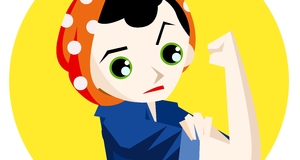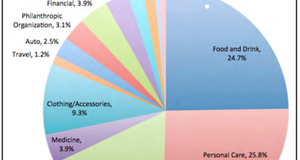|
From Elon Journal of Undergraduate Research in Communications VOL. 5 NO. 2 Feminine Agendas: The Historical Evolution of Feminism as Reflected in the Content of American Women's Magazines
By Kyra Gemberling
Elon Journal of Undergraduate Research in Communications
2014, Vol. 5 No. 2 | pg. 3/3 | «
Despite some general inconsistencies and variations, the majority of American women’s magazines from the 18th century to present day show a steady increase in support of feminist ideals based on several researchers that the author reviewed. By reading the articles published in these magazines, female readers were able to gain knowledge about the feminine agenda of their time. Over the course of three distinct periods studied, women’s magazines from the early 1770s to the late 1860s served as early advocates of female civic participation when female subservience was a cultural norm. Women’s magazines from the 1870s to 1970s encouraged female independence through involvement in academia and the workplace, mirroring the huge cultural and political changes in the United States during times of war.
Finally, women’s magazines from the 1980s to the present day provide empowering content that allows women to form their own, unique feminine identity in an age when a better variety of lifestyle choices are available. Furthermore, this research found that magazine authors over time were not the sole determinant of what ideas would be presented in the content their audience read. Female readers also had set the public agenda by providing commentary on the content of women’s magazines, and by writing content themselves. Women’s magazines have served as a reflection of America’s changing political and cultural landscape over the years, and they can be credited with delivering feminist ideals to an ever-developing, progressive female society.
The author is thankful to Dr. Michael R. Frontani at Elon University for his supervision and guidance, without which the article could not be published. The author also appreciates numerous reviewers who helped revise this article. Finally, the author especially wants to thank her family and friends for their unending love and support of her academic pursuits.
Aronson, Amy Beth. “Domesticity and Women’s Collective Agency: Contribution and Collaboration in America’s First Successful Women’s Magazine.” American Periodicals 11 (2001): 1-23.
Aronson, Amy Beth. Taking Liberties: Early American Women’s Magazines and Their Readers. Westport, CT: Praeger Publishers, 2002.
Ferree, Myra Marx and Beth B. Hess. Controversy and Coalition: The New Feminist Movement Across Four Decades of Change. New York: Routledge, 2000.
Flora, Cornelia Butler. “Changes in Women’s Status in Women’s Magazine Fiction: Differences by Social Class.” Social Problems 26, no. 5 (June 1979): 558-569.
Gauntlett, David. Media, Gender and Identity: An Introduction. New York: Routledge, 2008.
Hewitt, Nancy A. “From Seneca Falls to Suffrage? Reimagining a ‘Master’ Narrative in U.S. Women’s History.” No Permanent Waves, edited by Nancy A. Hewitt, 15-38. New Brunswick, NJ: Rutgers University Press, 2010.
McCall, Laura. “‘The Reign of Brute Force Is Now over’: A Content Analysis of ‘Godey’s Lady’s Book.’ 1830-1860.” Journal of the Early Republic 9, no. 2 (Summer 1989): 217-236.
Peterson, Theodore. Magazines in the Twentieth Century. Urbana, IL: University of Illinois Press, 1964.
Pierce, Jennifer Burek. “Science, Advocacy, and ‘The Sacred and Intimate Things of Life’: Representing Motherhood as a Progressive Era Cause in Women’s Magazines.” American Periodicals 18, no. 1 (2008): 69-95.
Starr, Martha A. “Consumption, Identity, and the Sociocultural Constitution of ‘Preferences’: Reading Women’s Magazines.” Review of Social Economy 62, no. 3 (September 2004): 291-304.
Taylor, Natalie Fuehrer. “The Personal Is Political: Women’s Magazines for the ‘I’m-Not-a-Feminist-But’ Generation.” In You’ve Come A Long Way, Baby: Women, Politics, and Popular Culture, edited by Lilly J. Goren, 215-32. Lexington: University Press of Kentucky, 2009.
Walker, Nancy A. “Critiques of the Women’s Magazines, 1946-1960.” In Women’s Magazines 1940-1960: Gender Roles and the Popular Press, edited by Nancy A. Walker, 228-61. Boston: Bedford/St. Martin’s, 1998.
Waller-Zuckerman, Mary Ellen. “‘Old Homes, in a City of Perpetual Change’: Women’s Magazines, 1890-1916.” The Business History Review 63, no. 4 (Winter 1989): 715-756.
Winship, Janice. Inside Women’s Magazines. New York: Pandora Press, 1987.
Zaslow, Emilie. Feminism, Inc.: Coming of Age in Girl Power Media Culture. New York: Palgrave Macmillan, 2009.
- Amy Beth Aronson, “Domesticity and Women’s Collective Agency: Contribution and Collaboration in America’s First Successful Women’s Magazine,” American Periodicals 11 (2001): 1.
- Ibid., 3.
- Ibid.
- Ibid., 5.
- Ibid., 6.
- Amy Beth Aronson, Taking Liberties: Early American Women’s Magazines and Their Readers (Westport, CT: Praeger Publishers, 2002): 78.
- Laura McCall, “‘The Reign of Brute Force Is Now over’: A Content Analysis of ‘Godey’s Lady’s Book,’ 1830-1860,” Journal of the Early Republic 9, no. 2 (Summer 1989): 228.
- Ibid., 231.
- Ibid.
- Ibid.
- Nancy A. Hewitt, “From Seneca Falls to Suffrage? Reimagining a ‘Master’ Narrative in U.S. Women’s History,” in No Permanent Waves, ed. Nancy A. Hewitt (New Brunswick: Rutgers University Press, 2010): 15.
- Mary Ellen Waller-Zuckerman, “‘Old Homes, in a City of Perpetual Change’: Women’s Magazines, 1890-1916,” The Business History Review 63, no. 4 (Winter 1989): 747.
- Ibid., 750.
- Nancy A. Walker, “Critiques of the Women’s Magazines, 1946-1960,” in Women’s Magazines 1940-1960: Gender Roles and the Popular Press, ed. Nancy A. Walker (Boston: Bedford/St. Martin’s, 1998): 228.
- Jennifer Burek Pierce, “Science, Advocacy, and ‘The Sacred and Intimate Things of Life’: Representing Motherhood as a Progressive Era Cause in Women’s Magazines,” American Periodicals 18, no. 1 (2008): 71.
- Cornelia Butler Flora, “Changes in Women’s Status in Women’s Magazine Fiction: Differences by Social Class,” Social Problems 26, no. 5 (June 1979): 563.
- Ibid., 567.
- Martha A. Starr, “Consumption, Identity, and the Sociocultural Constitution of ‘Preferences’: Reading Women’s Magazines,” Review of Social Economy 62, no. 3 (September 2004): 296.
- Ibid., 297.
- Myra Marx Ferree and Beth B. Hess, Controversy and Coalition: The New Feminist Movement Across Four Decades of Change, (New York: Routledge, 2000): 159.
- Natalie Fuehrer Taylor, “The Personal Is Political: Women’s Magazines for the ‘I’m-Not-a-Feminist-But’ Generation,” in You’ve Come A Long Way, Baby: Women, Politics, and Popular Culture, ed. Lilly J. Goren (Lexington: University Press of Kentucky, 2009): 216.
- Ibid., 217.
- Ibid.
- Ibid., 220.
- Ibid., 221.
- Ibid., 80-1.
- Ibid., 116.
- David Gauntlett, Media, Gender and Identity: An Introduction (New York: Routledge, 2008): 206.
- Winship, Inside Women’s Magazines, 158.
- Gauntlett, Media, Gender and Identity, 215.
- Ibid., 217.
Aronson, Amy Beth. “Domesticity and Women’s Collective Agency: Contribution and Collaboration in America’s First Successful Women’s Magazine.” American Periodicals 11 (2001): 1-23.
Aronson, Amy Beth. Taking Liberties: Early American Women’s Magazines and Their Readers. Westport, CT: Praeger Publishers, 2002.
Ferree, Myra Marx and Beth B. Hess. Controversy and Coalition: The New Feminist Movement Across Four Decades of Change. New York: Routledge, 2000.
Flora, Cornelia Butler. “Changes in Women’s Status in Women’s Magazine Fiction: Differences by Social Class.” Social Problems 26, no. 5 (June 1979): 558-569.
Gauntlett, David. Media, Gender and Identity: An Introduction. New York: Routledge, 2008.
Hewitt, Nancy A. “From Seneca Falls to Suffrage? Reimagining a ‘Master’ Narrative in U.S. Women’s History.” No Permanent Waves, edited by Nancy A. Hewitt, 15-38. New Brunswick, NJ: Rutgers University Press, 2010.
McCall, Laura. “‘The Reign of Brute Force Is Now over’: A Content Analysis of ‘Godey’s Lady’s Book.’ 1830-1860.” Journal of the Early Republic 9, no. 2 (Summer 1989): 217-236.
Peterson, Theodore. Magazines in the Twentieth Century. Urbana, IL: University of Illinois Press, 1964.
Pierce, Jennifer Burek. “Science, Advocacy, and ‘The Sacred and Intimate Things of Life’: Representing Motherhood as a Progressive Era Cause in Women’s Magazines.” American Periodicals 18, no. 1 (2008): 69-95.
Starr, Martha A. “Consumption, Identity, and the Sociocultural Constitution of ‘Preferences’: Reading Women’s Magazines.” Review of Social Economy 62, no. 3 (September 2004): 291-304.
Taylor, Natalie Fuehrer. “The Personal Is Political: Women’s Magazines for the ‘I’m-Not-a-Feminist-But’ Generation.” In You’ve Come A Long Way, Baby: Women, Politics, and Popular Culture, edited by Lilly J. Goren, 215-32. Lexington: University Press of Kentucky, 2009.
Walker, Nancy A. “Critiques of the Women’s Magazines, 1946-1960.” In Women’s Magazines 1940-1960: Gender Roles and the Popular Press, edited by Nancy A. Walker, 228-61. Boston: Bedford/St. Martin’s, 1998.
Waller-Zuckerman, Mary Ellen. “‘Old Homes, in a City of Perpetual Change’: Women’s Magazines, 1890-1916.” The Business History Review 63, no. 4 (Winter 1989): 715-756.
Winship, Janice. Inside Women’s Magazines. New York: Pandora Press, 1987.
Zaslow, Emilie. Feminism, Inc.: Coming of Age in Girl Power Media Culture. New York: Palgrave Macmillan, 2009.
Endnotes
- Amy Beth Aronson, “Domesticity and Women’s Collective Agency: Contribution and Collaboration in America’s First Successful Women’s Magazine,” American Periodicals 11 (2001): 1.
- Ibid., 3.
- Ibid.
- Ibid., 5.
- Ibid., 6.
- Amy Beth Aronson, Taking Liberties: Early American Women’s Magazines and Their Readers (Westport, CT: Praeger Publishers, 2002): 78.
- Laura McCall, “‘The Reign of Brute Force Is Now over’: A Content Analysis of ‘Godey’s Lady’s Book,’ 1830-1860,” Journal of the Early Republic 9, no. 2 (Summer 1989): 228.
- Ibid., 231.
- Ibid.
- Ibid.
- Nancy A. Hewitt, “From Seneca Falls to Suffrage? Reimagining a ‘Master’ Narrative in U.S. Women’s History,” in No Permanent Waves, ed. Nancy A. Hewitt (New Brunswick: Rutgers University Press, 2010): 15.
- Mary Ellen Waller-Zuckerman, “‘Old Homes, in a City of Perpetual Change’: Women’s Magazines, 1890-1916,” The Business History Review 63, no. 4 (Winter 1989): 747.
- Ibid., 750.
- Nancy A. Walker, “Critiques of the Women’s Magazines, 1946-1960,” in Women’s Magazines 1940-1960: Gender Roles and the Popular Press, ed. Nancy A. Walker (Boston: Bedford/St. Martin’s, 1998): 228.
- Jennifer Burek Pierce, “Science, Advocacy, and ‘The Sacred and Intimate Things of Life’: Representing Motherhood as a Progressive Era Cause in Women’s Magazines,” American Periodicals 18, no. 1 (2008): 71.
- Cornelia Butler Flora, “Changes in Women’s Status in Women’s Magazine Fiction: Differences by Social Class,” Social Problems 26, no. 5 (June 1979): 563.
- Ibid., 567.
- Martha A. Starr, “Consumption, Identity, and the Sociocultural Constitution of ‘Preferences’: Reading Women’s Magazines,” Review of Social Economy 62, no. 3 (September 2004): 296.
- Ibid., 297.
- Myra Marx Ferree and Beth B. Hess, Controversy and Coalition: The New Feminist Movement Across Four Decades of Change, (New York: Routledge, 2000): 159.
- Natalie Fuehrer Taylor, “The Personal Is Political: Women’s Magazines for the ‘I’m-Not-a-Feminist-But’ Generation,” in You’ve Come A Long Way, Baby: Women, Politics, and Popular Culture, ed. Lilly J. Goren (Lexington: University Press of Kentucky, 2009): 216.
- Ibid., 217.
- Ibid.
- Ibid., 220.
- Ibid., 221.
- Ibid., 80-1.
- Ibid., 116.
- David Gauntlett, Media, Gender and Identity: An Introduction (New York: Routledge, 2008): 206.
- Winship, Inside Women’s Magazines, 158.
- Gauntlett, Media, Gender and Identity, 215.
- Ibid., 217.
Save Citation » (Works with EndNote, ProCite, & Reference Manager)
APA 6th
Gemberling, K. (2014). "Feminine Agendas: The Historical Evolution of Feminism as Reflected in the Content of American Women's Magazines." Elon Journal of Undergraduate Research in Communications, 5(2). Retrieved from http://www.inquiriesjournal.com/a?id=1039
MLA
Gemberling, Kyra. "Feminine Agendas: The Historical Evolution of Feminism as Reflected in the Content of American Women's Magazines." Elon Journal of Undergraduate Research in Communications 5.2 (2014). <http://www.inquiriesjournal.com/a?id=1039>
Chicago 16th
Gemberling, Kyra. 2014. Feminine Agendas: The Historical Evolution of Feminism as Reflected in the Content of American Women's Magazines. Elon Journal of Undergraduate Research in Communications 5 (2), http://www.inquiriesjournal.com/a?id=1039
Harvard
GEMBERLING, K. 2014. Feminine Agendas: The Historical Evolution of Feminism as Reflected in the Content of American Women's Magazines. Elon Journal of Undergraduate Research in Communications [Online], 5. Available: http://www.inquiriesjournal.com/a?id=1039
Suggested Reading from Inquiries Journal
Who is a woman? What does it mean to be a woman? Is she a mother-daughter-wife-sister? Or is she more than that? What is her role in society and how does it play out in various institutions? Does she really face oppression? If so, how? Is Feminism really an answer to her problems? And does she need emancipation? Who will bring about... MORE»
The purpose of this study was to analyze advertisements in magazines targeting women readers and find the preferred type of appeals advertisers used. This study analyzed 590 advertisements in three women's interest magazines... MORE»
Since the early 20th century, the feminist movement has made enormous strides to improve the status of female athletes. Prior to the movement’s achievements, female athletes had to play in much poorer facilities, under different rules, and with stricter dress codes than male athletes. Society also largely ignored and discriminated... MORE»
Sex work has long been criticized and stigmatized in our society. While many members of society view sex work as immoral and degrading to women, I argue that sex work is essentially just work, and that it is not necessarily harmful to women. Under circumstances in which sex work is accepted and regulated in society, in which the... MORE»
Latest in Women's & Gender Studies
2022, Vol. 14 No. 10
The label of ‘science’ or ‘biology’ can become somewhat of a trump-card in excluding trans people from civil rights, because many scientific (and pseudo-scientific) opinions are weaponized during transgender rights debates... Read Article »
2022, Vol. 14 No. 09
Perceptions of menstruation as a taboo subject have historically characterized Western and non-Western societies alike and persist today, both perpetuating harmful cultural understandings of women’s abilities and normalizing institutional... Read Article »
2022, Vol. 14 No. 03
Using content analysis, this article focuses on the portrayal of female prisoners in the first two seasons of the Netflix show Orange is the New Black (OITNB). There are two main findings. First, the word "lesbian" frequently signals homophobia... Read Article »
2020, Vol. 12 No. 11
This paper investigates the convoluted societal processes to which the individual is exposed from an early age in order to form and acquire their sense of identity, and aims at dismantling these very processes by exhibiting their flimsy and unsubstantiated... Read Article »
2020, Vol. 12 No. 10
Centuries of subjugation under Spanish and American colonial rule have embedded an idealistic view of white beauty in the minds of Filipinos. It continues to be deeply rooted in Philippine culture due to the constant exposure of Filipina bodies... Read Article »
2020, Vol. 12 No. 10
This paper explores the woman’s body as a site of sanctity and disgust in the film Rosemary’s Baby. The character of Rosemary Woodhouse is depicted as a pure, virtuous, and feminine figure. She is positioned against other corrupted,... Read Article »
2020, Vol. 12 No. 10
Conversations about the gender expression of young children are often characterized by confusion, as parents, educators, and even child psychologists have a hard time determining where exactly children’s strong gendered beliefs and behaviors... Read Article »
|




















